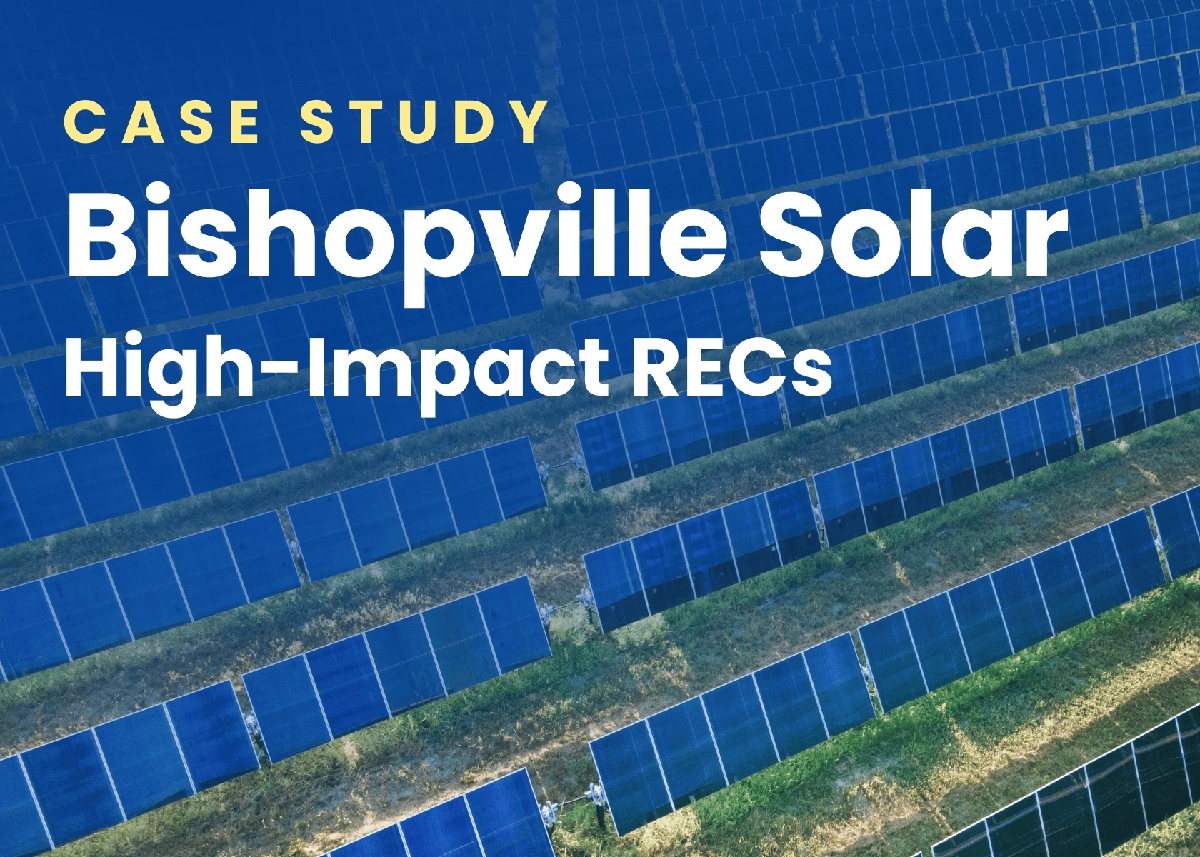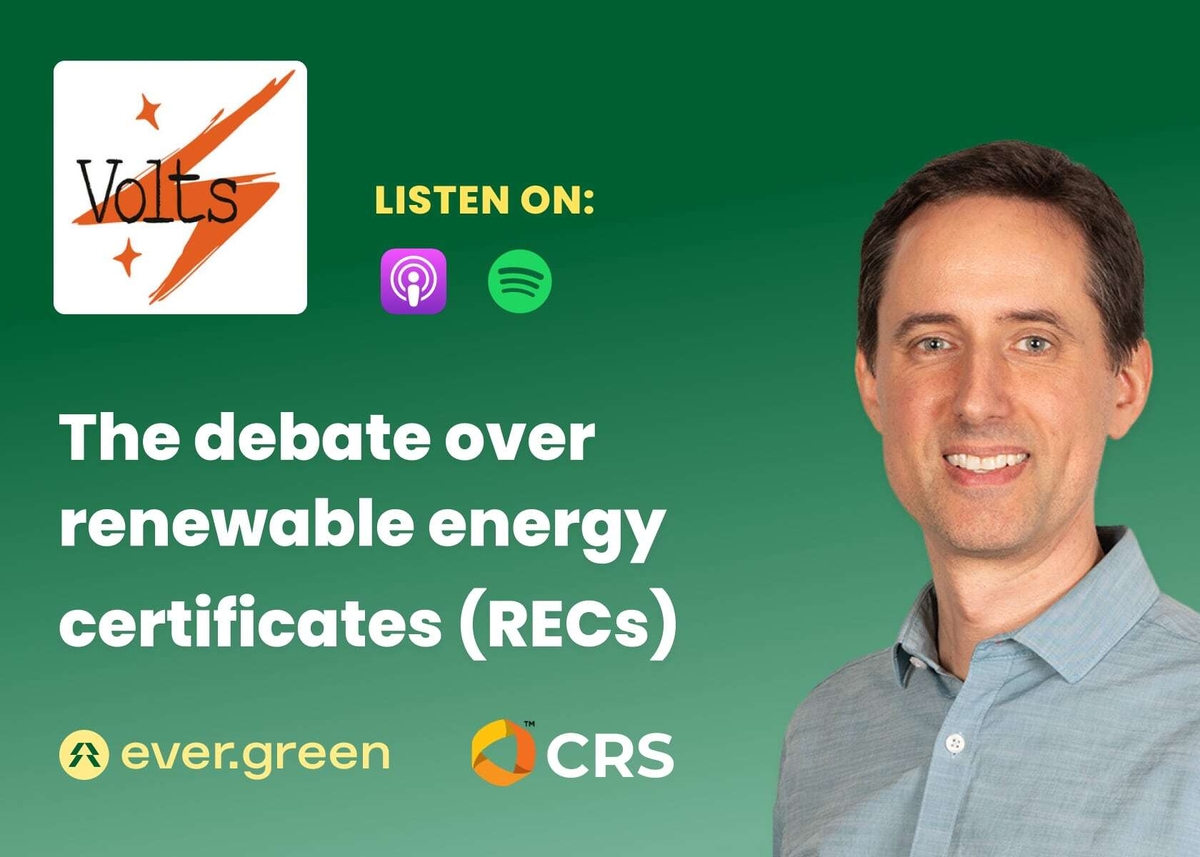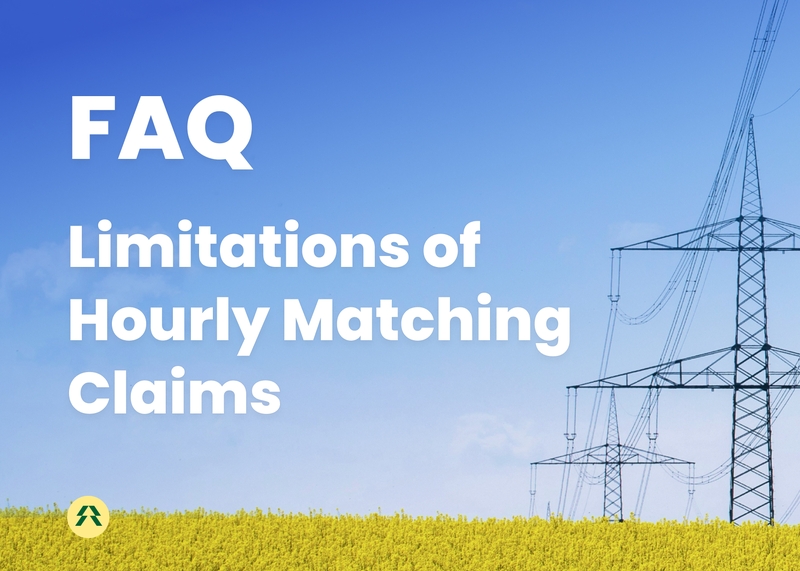Future-Proofing Your REC Procurement Against Evolving Requirements
How to align your renewable energy strategy with GHG Protocol, SBTi, CDP, and RE100—while securing long-term impact, transparency, and future compliance.
July 16, 2025
Corporate sustainability leaders face a growing challenge: navigating multiple overlapping renewable energy frameworks while ensuring procurement decisions drive real climate impact. The question is no longer whether to buy renewable energy certificates (RECs), but how to procure them in ways that satisfy increasingly rigorous standards for carbon accounting, disclosure, and additionality.
Navigating the Landscape of Renewable Energy Guidelines
The renewable energy procurement ecosystem is built on the foundational rules of the Greenhouse Gas (GHG) Protocol, particularly its Scope 2 Guidance, which introduced the concept of market-based accounting for electricity emissions. Nearly all other frameworks build on this foundation and fall into two key categories:
Target-Setting Initiatives:
- Science-Based Targets initiative (SBTi): Applies GHG Protocol’s rules across Scopes 1, 2, and 3 to define credible corporate decarbonization pathways. For Scope 2 emissions, the current SBTi Corporate Net-Zero Standard V1.2 defers to GHG Protocol Scope 2 guidance and allows broad use of RECs without specific high-impact procurement requirements. While SBTi has proposed renewable electricity targets for some sectors—such as 80% by 2025 and 100% by 2030—these are not yet universal.
- RE100: Builds on Scope 2 guidance by requiring 100% renewable electricity and establishing an impact-oriented three-pillar framework: (1) long-term procurement, (2) recent commissioning (≤15 years old), and (3) project-specific sourcing.
Climate Disclosure Frameworks:
- CDP (originally Carbon Disclosure Project): Adds scoring incentives for purchases with additionality and mandates strict rules on project vintage and geographic matching. It clarifies how companies should apply the GHG Protocol’s market-based method.
- Others (e.g., TCFD, SASB, GRI): These primarily govern financial disclosure and are not addressed in detail here.
Underpinning this ecosystem in North America is Green-e, a voluntary certification program for renewable energy operated by the Center for Resource Solutions (CRS). Green-e provides baseline certification standards for REC integrity, tracking, and consumer protection. While Green-e certification ensures fundamental quality and prevents double-counting, the frameworks above layer additional requirements for additionality, geographic specificity, and temporal matching that go beyond Green-e's current standards.
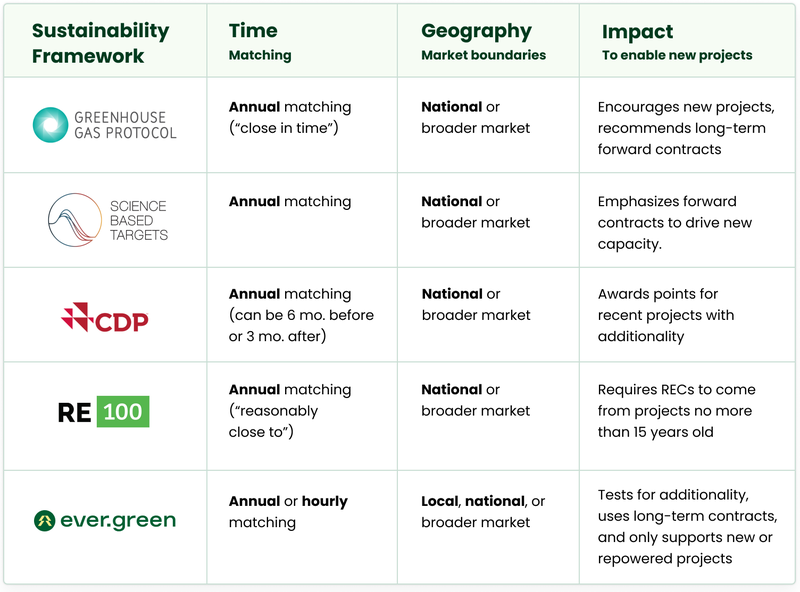
Current Standards Face Scrutiny
Critics argue that today’s standards allow companies to claim climate benefits without delivering real emissions reductions. Two central concerns have emerged:
- Lack of Impact: Most RECs are purchased from existing projects via spot markets at low prices, offering little financial incentive for new development. Today, the vast majority of REC buyers follow this model, representing 50% of market volume. (The other half comes from a small group of large buyers using long-term contracts like Power Purchase Agreements (PPAs) to support new builds.)
- Usage Mismatch: RECs are often used to address electricity usage that does not match the time and/or location of generation (e.g., solar RECs generated during the day being used to cover overnight consumption or Texas RECs being applied to Hawaii operations).
Leading voices have called these issues out
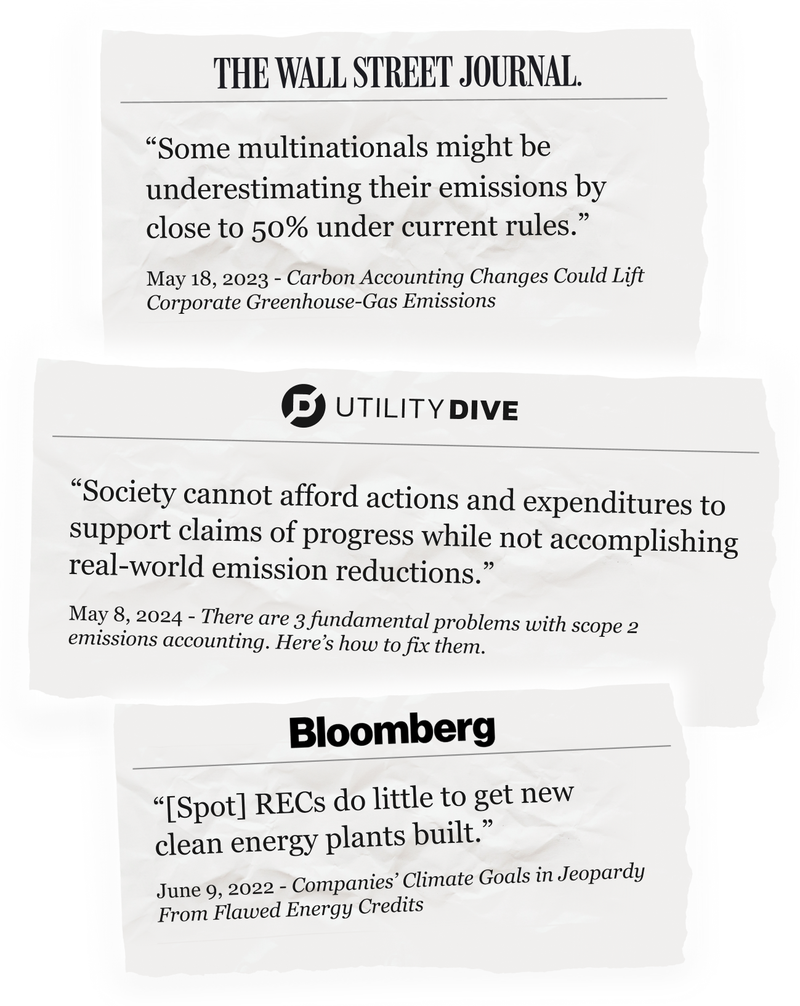
In response, key frameworks are updating their guidance:
- GHG Protocol is revising Scope 2 Guidance for the first time in a decade, with final rules expected by the end of 2027, and new requirements taking effect in 2028 or 2029.
- SBTi is drafting version 2.0 of its target-setting criteria to include more rigorous requirements for spatial and temporal matching, to be used for targets set in 2027 and after.
Framework Criteria for Future-Proof REC Procurement
To align with both current expectations and future updates, companies should evaluate REC strategies based on three pillars that underlie nearly all framework requirements:
1. Time-matching: When Was the Energy Generated?
Why it matters: To support the credibility of claims, frameworks generally want the retired RECs to represent electricity generated during the same period as the electricity consumed.
Current Framework Positions:
- GHG Protocol: Annual matching is currently allowed so that generation is “close in time to the reporting period for which the [RECs] are claimed.”
- SBTi: Annual matching is currently allowed to align with GHG Protocol and RE100.
- CDP: Requires RECs be generated in a 21-month window relative to matched electricity consumption: in the same calendar year or up to 6 months before or 3 months after.
- RE100: RECs “must be reasonably close to the reporting year of the electricity consumption to which it is applied.” RE100 does not define reasonable but does point to CDP’s 21-month vintage eligibility window as an example.
What’s changing: Frameworks are evaluating moves toward hourly matching to more accurately reflect usage claims, but there has been a great deal of pushback that strict hourly requirements could make impactful renewable energy procurement less accessible and less impactful.
2. Geographic-matching: Where Was the Energy Generated?
Why it matters: Sourcing RECs from the same market in which the buyer consumes electricity, strengthens the credibility of claims and aligns with the way electricity markets function. It also helps avoid issues like double-counting when grid boundaries and certificate tracking systems are not aligned globally.
Current Framework Positions:
- GHG Protocol: Requires RECs to be sourced from the same market, typically defined by national or regional grid boundaries
- SBTi: Follows GHG Protocol market-based accounting rules, stating that “RECs need to be purchased and used within the same market..”
- CDP: Defined markets for North America and the Europe Union, definitions that have been adopted by other frameworks. CDP explicitly prohibits “global matching” (e.g., using RECs from Europe to address consumption in the U.S.).
- RE100: Follows CDP’s definition for market boundaries and specifically states “there are advantages to larger market boundaries that allow consumers to source renewable electricity where it may be less expensive to create.”
What’s changing: Frameworks are considering narrower definitions of “same market,” placing greater emphasis on local sourcing. However, broader market boundaries can make more impactful procurement methods accessible and allow buyers to support projects in regions where the grid is dirtier, thus increasing the climate impact of their actions.
3. Impact: Does the REC Purchase Enable New Projects?
Why it matters: Only procurement that enables new renewable capacity, usually through long-term contracts, can credibly claim to reduce emissions and contribute to decarbonization.
Current Framework Positions:
- GHG Protocol: Lists eight quality criteria and encourages direct procurement from new projects and use of long-term forward contracts
- SBTi: Emphasizes forward contracts that drive new capacity
- CDP: Awards points for purchases from recently commissioned projects
- RE100: Requires that RECs come from projects less than 15 years old and recommends sourcing via long-term, project-specific contracts
What’s changing: Frameworks are tightening requirements to improve the credibility of claims about the impact of corporate action. Long-term contracts signed today not only support new clean energy capacity but also lock in eligibility under current standards—providing buyers with compliance certainty, reduced future reporting complexity, and protection from more restrictive rules that may emerge later.
How High-Impact RECs Meet and Exceed Framework Requirements
Unlike spot-market RECs, Ever․green's High-Impact RECs are structured to satisfy the most stringent criteria across all frameworks, allowing companies to comply with evolving standards and defend their climate impact claims with confidence. Our approach addresses the core challenges identified by framework developers and sustainability experts:
1. Consequential Procurement
While the major frameworks emphasize the importance of enabling new projects, Ever․green is one of the only providers that requires proof of additionality. Ever․green‘s High-Impact RECs align with recommendations as well as the latest research & publications on indicators of impact. Every REC contract is tested for:
- Financial Additionality: Every project undergoes a rigorous diligence process to confirm that REC revenues improve financial metrics (e.g., IRR, DSCR) by >10%, directly enabling development
- New Build or Repowered Projects: RECs originate from projects that are either yet to be built or repowered
- Long-Term Agreements: Provide developers with revenue certainty, unlocking financing for new projects
2. Impact Scorecard
Each renewable energy project is vetted across:
- Climate Impact: Projected avoided emissions and grid decarbonization
- Environmental Stewardship: Analysis of co-benefits and harm minimization
- Community Benefit: Evaluation of local economic and social outcomes
3. Granular Retirement and Future-Proof Transparency
Ever․green goes beyond today’s requirements from GHG Protocol, SBTi, CDP, and RE100 by embracing best practices that enhance both impact and transparency. These practices position buyers for future compliance without sacrificing the credibility or effectiveness of their climate action.
- Hourly Metadata: Each REC includes serialized metadata with the exact hour and location of generation—enabling precise matching if needed.
- Ready for Granular Matching: Ever․green can support buyers who wish to match generation to their own time- and location-specific usage records. However, we also caution that strict hourly matching can limit the feasibility of long-term, high-impact procurement.
- Audit-Ready Documentation: Every REC retirement includes traceable connection to the project, production, and impact, ensuring alignment with today’s guidance, and adaptability to the potential standards of the future.
Strategic Takeaways for Sustainability Leaders
To prepare for evolving standards and rising stakeholder scrutiny, companies should assess:
- Current Performance: How does your procurement strategy align with the pillars of time, geography, and impact?
- Framework Evolution: Which frameworks apply to your organization, and what changes are coming?
- Stakeholder Expectations: Are investors, customers, and rating agencies demanding higher standards of integrity and impact?
Conclusion: From Compliance to Climate Impact
The expectations of future renewable energy procurement practices are becoming clear: deeper scrutiny, higher standards, and better climate outcomes. Ever․green’s High-Impact RECs, which provide verifiable additionality and granular time and location data, offer a ready pathway to meet both today’s standards and evolving expectations. Ready to evaluate your renewable energy strategy? Get in touch.
———
Related Resources:
Hidden Risks of Hourly Matching: Why Stricter Rules Could Slow Clean Energy Progress - The paper dives deeper into the risks, tradeoffs, and unintended consequences of hourly matching, along with a practical, impact-driven alternative grounded in real-world experience.
Ever․green's Additionality Methodology - This methodology provides a systematic approach to distinguish RECs that genuinely accelerate renewable energy development from those that offer only accounting benefits, addressing the critical gap between corporate renewable energy claims and actual clean energy deployment through three practical evaluation criteria: financial impact, project viability, and market expansion.
Indicators of Clean Electricity Procurement That Drives New Supply - This paper presents 14 indicators developed by the Clean Energy Accounting Project to help voluntary clean electricity buyers identify procurement strategies that effectively drive new clean energy development and maintain existing generation, addressing market fragmentation caused by unclear guidance on what constitutes high-impact purchasing decisions.
Technical Documents from Frameworks:
- Greenhouse Gas Protocol’s Scope 2 Guidance
- Greenhouse Gas Protocol's public meeting notes and presentations from revision working groups
- Science-Based Targets Initiative Net Zero Standard v1.2
- Science-Based Targets Initiative Draft v2.0
- CDP Technical Note: Accounting of Scope 2 emissions
- RE100 Technical Criteria
- Green-e North America Standard



